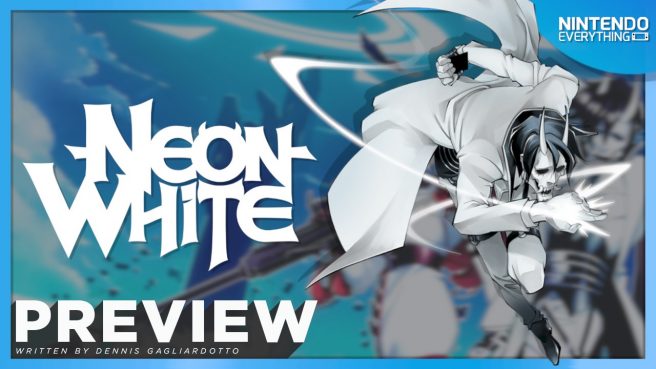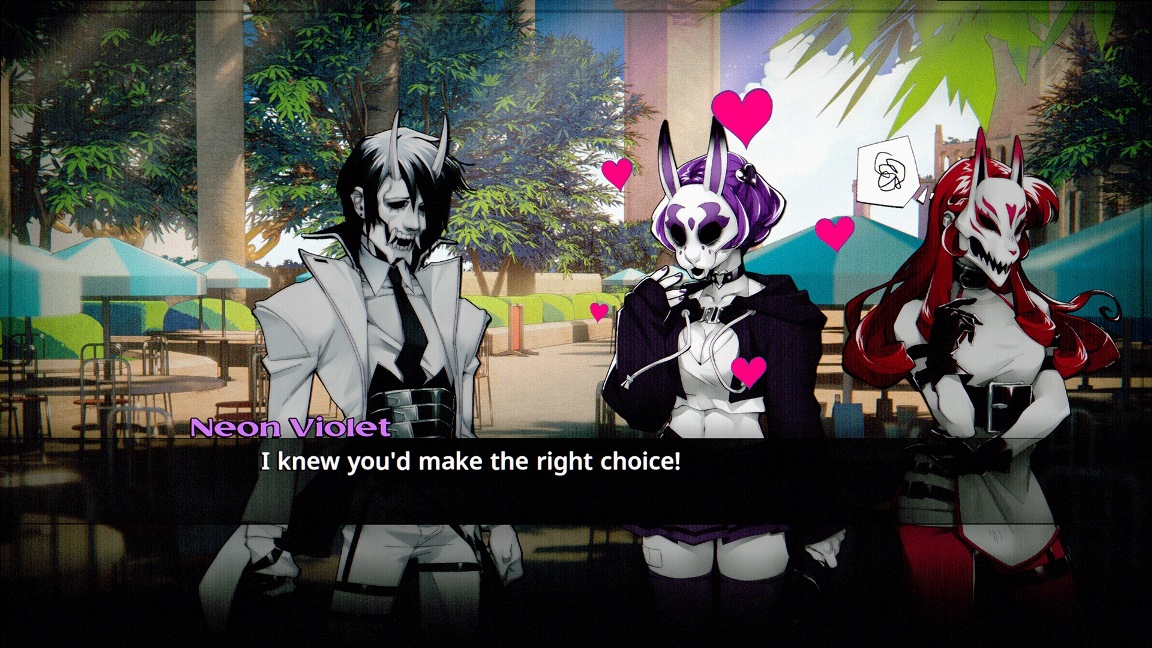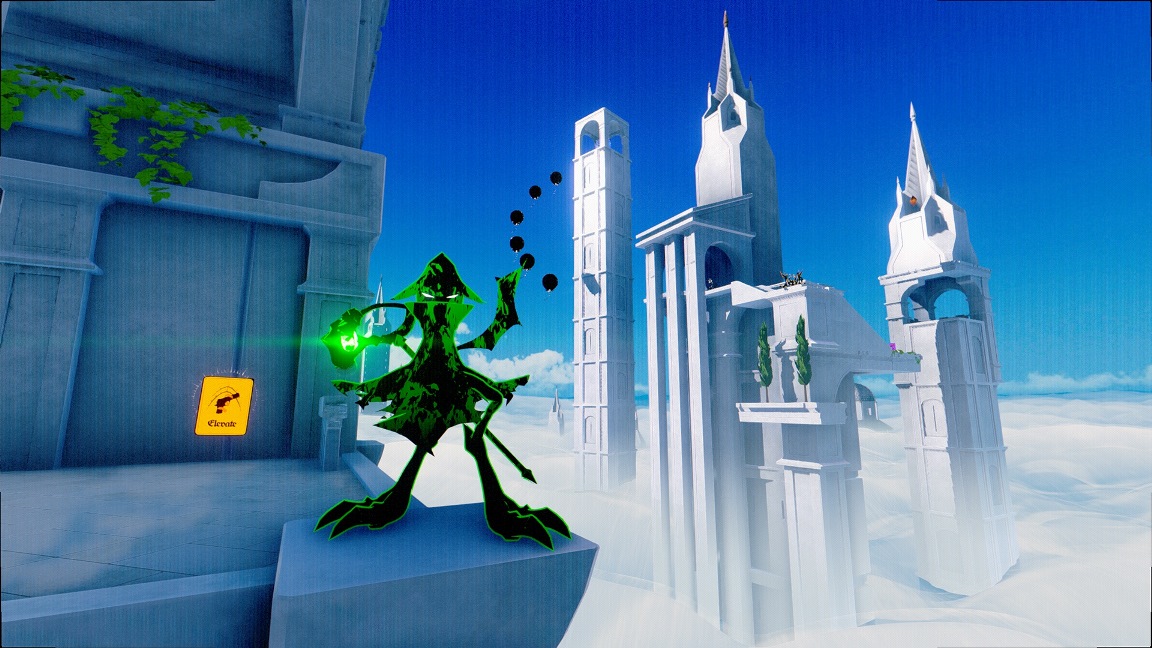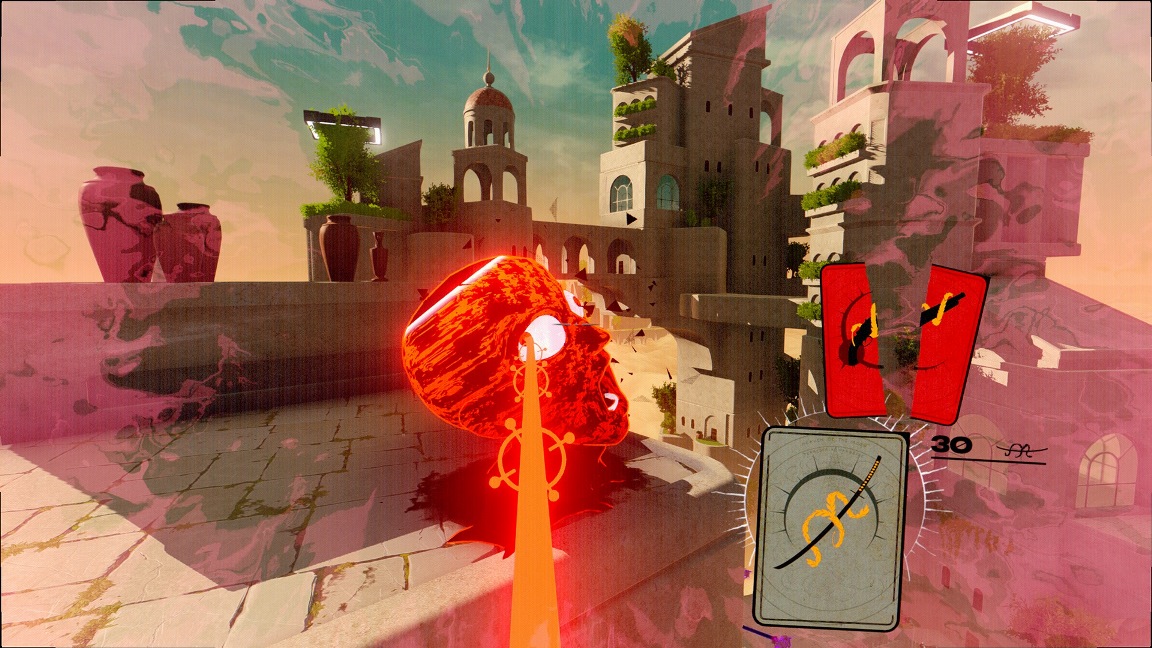[Preview] Neon White is a stylish perspective on speedrunning, parkour, heaven, and hell
Annapurna Interactive has long been one of my favorite publishers with a catalog that’s unrivaled thanks to some of the most unique and memorable games the medium has seen. I’ve always said they’re the video game equivalent of what A24 is to film, and their ability to consistently bring together and showcase talent from a wide array of indie developers is what will always make them stand out within the industry. It’s no surprise then that they’d once again work together with the ever-evolving, consummate artistry that makes of the foundation of Ben Esposito’s creative intellect for his new Switch game, Neon White. With credits under his belt showcasing works across What Remains of Edith Finch, Tattletail, and Donut County, it’s clear that there’s no way to describe his work other than eclectic and forward-thinking, and with our recent invitation to see him personally present Neon White to journalists, it’s clear that the game is set to be another big hit with a game that’s as exciting and refreshing as it is fast and flashy.
During our time watching Esposito play through a bit of Neon White and talking about the game, we were introduced to its story as well as a plethora of levels and design philosophies as he discussed all the things that make up the heart and soul of what Neon White is supposed to be, from its parkour, fps, and visual novel hybrid storytelling, inspirations, goals, and more. Firstly, we got a taste of what the story was supposed to be about and some of the topics and themes that touch upon a multitude of elements, including some more sensitive and serious themes such as religion. Morality drives each of the assassins which fill the cast of characters in Neon White, all of which are named after a certain color.
Mainly, however, you play as White throughout the game – voiced by the prolific and illustrious Steve Blum – and are handpicked alongside other slayers from Hell for a chance to live in Heaven. While memories themselves across all characters are spotty, everyone has a sense of familiarity with each other, and all this unravels as we make our way through the many levels and missions Neon White has to offer. Naturally, curiosity built when wanting to find out more about the story since half of the game is presented in a visual novel style format, and religion has been interpreted and touched upon in games in a multitude of ways, so the question spawned of how exactly they were going to touch on those topics and how certain tones would be conveyed when talking about Heaven and Hell and how they’re being used here.
“There are religious themes that we don’t take particularly lightly. The tone of the game seems ironic and flippant, but that was kind of a tool we used to disarm you a bit. [Neon White] does talk about religious themes in a different way one would expect, and it’s done this way to be more impactful while remaining comfortable… They talk about their failures in life and what they’d do with a second chance. Thinking it’s lighthearted and silly and becoming vulnerable and open to it over time makes the experience much more special that way.”
As we watched Esposito go through a few more levels of Neon White, it was clear that the juxtaposition and contrast of its presentation compared to the dialogue placed in its more serious moments undoubtedly makes thing significantly more interesting, and I couldn’t help but get vibes of Doki Doki Literature Club because of this. It’s worth noting also, though, that one of his favorite games of all time is also Killer7 and he takes huge inspiration from Suda51, so that also was a natural appeal in the creative direction the aesthetic and vibe.
The bulk of Neon White will be taking place in Central Heaven. As we were walked through the area, it was clear that the project is arguably one of the most polished games Esposito and the rest of the team have developed with a ton of passion and love that harkens back to the likes of late 90s and early 2000s aesthetic, which he explicitly stated was a big influence for them when finding an art style that they wanted to play around with, but do so in a way that was still capable of finding its own identity. Humorously, there was an intentional amount of cringe, but it came from a source of love as they wanted to touch upon how things naturally were back then with the overemphasis of one-liners. So the question naturally came to light: How does “embracing cringe” work in Neon White’s world?
“We’re sick of subversion. People make fun of tropes, and yes things are tired and overdone, but they’re also sick of subverting things for the sake of subverting things just because it’s an indie game. It is what it is – fun, campy, and melodramatic and gets serious. It’s self-indulgent, and we’re not afraid to use tropes in a way that’s actually fun. We’re not relying on them because they can’t come up with anything else, but using them in a way that’s advantageous and because they actually like them and being a product of its time – it’s a way to embrace and celebrate. Cringe can be earnest and funny.”
He specifically noted the likes of Cowboy Bepop and Trigun as personal favorites that helped with the direction of the game, and that a big part of the tone and desire to work with Steve Blum was because of his credit as Spike Siegel and for being the essential prototype and template. Interestingly, Esposito talked about how Neon White was never intended to have voice acting until the idea was brought up by Annapurna to do so. Esposito went on to say how when Annapurna asked who Ben wanted to ideally get to voice Neon White, he said “They should sound like Steve Blum.”
Annapurna: “OK, but do you just want Steve?”
Esposito: “Can we do that?!”
So Annapurna and Esposito’s team got into contact with him, and Blum was hugely excited about it, which was amazing to them. Blum was even more excited about the anime references than Esposito was, which was already coming from an place of passion and being longtime fans of him and his work in general.
“We didn’t think we could get Steve Blum. We weren’t planning on voice acting in the beginning until Annapurna had brought up the idea and asked what they were thinking and who they should sound like. Steve is the prototype cool English dub voice actor, and he reads lines great the first time every time, so he was a dream to work with.”
The biggest draw Neon White obviously has that sets it apart from other titles we’ve seen over the years that utilize speed, platforming, and parkour like Ghostrunner, Dying Light, Mirror’s Edge, or Super Cloudbuilt is the use of a card-based system to represent weapons and abilities rather than actually designing physical weapons. Much like anything in development, however, ideas change and come and go, and the game went through a few iterations, and initially wasn’t even meant to have a speedrunning focus to begin with. The important thing to Esposito is that it was clear the game was going to be way different than other titles in the genre, so displaying the cards were a signifier that you’re not supposed to think about weapons in this game the same way you do in other FPS experiences – it would be too distracting to do so to keep all attention and focus on the screen and platforming itself.
Each card has two functions in the form of abilities and powers. Was this set in stone since the beginning or was this something that came to be over time for in-game flexibility?
“Originally Neon White was not a speedrunning game. The idea of the cards came first, but they were just weapon cards and meant for deck-building, but the card building being random didn’t work well for an FPS. We wanted it to be predictable in a way that you know what you’re gonna get and what you want when you want it.”
Resources are built into a level and utilized in a way specifically for that level, so card resources matching movement ability came from this.
“We want tons of variety and freedom, but by having hard constraints on the player with a set limit of cards at any given time, the more fun, interesting, and fascinating the speedruns and optimizations became because you aren’t bombarded or hindered with, and by, spontaneous cards [and mechanics making for inconsistency and loss of focus and traction]. We want to make sure the constraints are more of a way to free yourself within the level rather than limit mobility or creativity, finding clever uses with what you have than working around what you don’t.”
Neon White is fast-paced from beginning to end, and it’s meant more so for short bursts which is why the levels themselves are so short. The design of these stages grow incredibly deep over time, however, and it’s clear that each is meant to be played multiple times not only to become highly proficient and skilled within a mission and level, but to find, create, and optimize the best possible paths within each to keep getting a quicker and quicker time. Some levels can be finished so fast to the point where you can have a clear time of just a few seconds, though this won’t always happen on a first run and will be done through excessive (and almost obsessive) replaying of levels to take advantage of cards and enemy placement for the quickest times.
Outside of card abilities, jump pads, enemy reactions, and how certain weapons react to the environment can make for a wonderful combination of platforming and parkour prowess that is almost reminiscent of the likes of Quake and Team Fortress in which you can utilize not only speed but physics with certain weapons like rockets for a rocket jump to help propel you further through Neon White’s aerial space. There’s a hint system that’s structured in a certain way to engage with speedrunning the levels and optimizing them but not necessarily meant to be the solution or quickest route to beating a level. Shortcuts recommended are basic at best, but levels can be played any multitude of ways with tons of shortcuts even they didn’t even know about. Through testing, even Esposito and his team were constantly finding new ways to beat a level. This also brought up a very interesting thought about the flexibility of the levels and that with their richness and depth even within such a small space if the idea of a possible level editor would ever come to be, in which Esposito responded, “[There are] no plans at the moment, but the thought of it is certainly exciting to see what people can make. It just depends on how bad the people want it!”
Neon White was primarily being played on PC, but Esposito assured us that the Switch version was very important and the reason why it was the console of choice. Parity was essential, as was 60 FPS, and was taken so seriously to the point that a lot of assets had to be made from the ground up with all shaders and materials having to be recreated specifically for the Switch version so it could run at such a high frame rate. There are some slight differences between the PC and Switch versions, but nothing particularly massive or jeopardizing.
The biggest difference is the fact that on Switch, there are gyro capabilities, which are set in a number of ways depending on whether you’re playing with Joy-Con attached or detached. The team went through rigorous testing to make sure gyro was not only comfortable, but accessible depending on the playstyle. In a way, it also makes it competitive depending on your setup, and gives off a similar style to playing with a mouse and allows for quick reactions and turns. Responsiveness was hugely important for the Switch version, which is why the team dedicated so much time and resources to ensuring there was virtually no differences and things were kept as close to 1:1 as possible – and they are. The quality was a necessity despite the “pain and suffering”, and they wanted to emphasize that Switch is not a second-tier platform.
While there’s still no set date yet for when we’ll get to add Neon White to our libraries, rest assured that it doesn’t seem like we’ll have to wait much longer as the game looks well underway and filled with plenty of polish. Not to mention, the Switch version of the game is being filled with just as much time and care as the PC release. The game is inherently simple, but a big part of that has to do with efficiency so just about anyone can pick up and play at their leisure with that lean towards competitiveness within the levels themselves to beat your own times should the player feel the need to do so. Esposito is a creative mind that introduces new concepts and ideas while making the art feel familiar and fresh, and with how great Donut County was on the Switch, I have no doubt that Neon White will follow suit in providing an experience that will once again stand out on the console.





